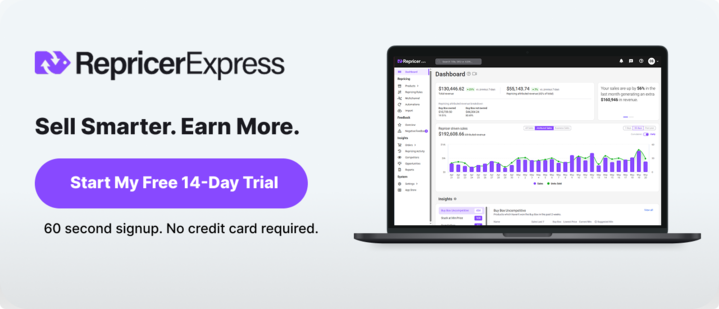How do you stay price-competitive without losing margin? In short, you set cost-aware floors, target the right rivals, and use rules that win the Featured Offer while protecting profit. Add inventory and demand signals, and you’ll compete hard without cutting into the numbers that keep you in business.
For the full picture on how to nail competitive pricing, this guide breaks down practical tactics you can use today, with clear workflows and official sources you can share with your team.
What “competitive pricing” really means on marketplaces
On Amazon and other marketplaces, “competitive” is the best overall offer: price, delivery speed, stock, and seller performance. That’s why the Featured Offer (what most sellers still call the Buy Box) matters so much. One offer gets the default Add to Cart position at a time, and that position drives the lion’s share of sales.
It’s tempting to focus on the lowest price, but you need to win at a price that meets your profit target. That’s where floors, guardrails, and smart rules pay off.
More than 60% of sales in Amazon’s store come from independent sellers, according to Amazon’s Small Business Empowerment Report.
Set floors that protect margin before you reprice
Before you think about beating competitors, lock in your numbers:
- Know your landed cost for each SKU, including product, inbound shipping, prep, FBA or fulfillment fees, storage, and advertising.
- Set a minimum price that covers costs and hits your target ROI or contribution per unit.
- Add a “comfortable” buffer above that minimum to cover fee swings and unexpected promos.
- Use different floors by channel if fees differ.
Remember that platforms monitor price fairness, so if your price is wildly out of range, you can lose visibility or get unpublished.
Rules that win the Featured Offer without a race to the bottom
Once floors are set, tune rules to win and then lift. Shoot for the Featured Offer, not rock-bottom. Also, keep an eye on the top price and adjust, but don’t go under your floor. Ignore the noise and don’t chase sellers with slow shipping, shaky feedback, or a different condition so you’re comparing like with like.
When you win the spot, ease the price up in tiny steps to test demand and protect margin. Mix tactics as you go—sometimes a few cents is enough, sometimes a small percent works better depending on the price band.
If you want a simple way to see this in action, plug a few SKUs into an Amazon repricer that supports floors, exclusions, and post-win price increases. You’ll keep margin while raising your Featured Offer share.
Over 55,000 independent sellers topped $1M in annual sales in 2024, per Amazon’s 2024 Small Business Empowerment Report.
Target the right rivals and ignore the noise
Not every offer is apples to apples. Make your rules as smart as your real-world judgment, like this:
Line up like with like. If you ship fast, compete against FBA and other quick-delivery offers, and skip the slow ones so you don’t give away margin. Stick with reputable sellers and let low-rated outliers undercut without pulling you in. Also, compare the same offer type every time (new, used, renewed, or a bundle) and price against a true match. Last of all keep an eye on Amazon Retail: if Amazon is on the listing, switch up the play by holding price when their stock is tight or pivoting to an alternate SKU.
And if eBay’s part of your mix, use offer-based tactics instead of constant price drops.
Use inventory and demand to guide price moves
Price should move with reality rather than on a timer, so make sure you bring stock and sell-through into the plan:
- When stock is low and demand is steady, lift price in small steps to stretch inventory until you replenish.
- If stock is aging, discount in stages, add coupons, or bundle to recover capital.
- For fast movers, test price up until velocity drops, then find the ceiling and ride it.
- During trend spikes, react to traffic and conversion together, not traffic alone.
On Walmart, “competitive” is a moving target too. Their guidance is simple: stay close to the Buy Box price or the most competitive external price.
Global eCommerce net sales at Walmart rose 22% in Q1 FY26, according to their earnings release.
Keep pricing clean across every channel
If your price is way out of line on one marketplace, you can lose visibility on another. Consistency matters, even if fees and promos vary by channel. Replicate your base strategy everywhere, then layer channel-specific tweaks for fees, logistics, and audiences.
When you scale beyond one marketplace, consider tools that standardize your rulebook. For example, RepricerExpress’s repricing features are built to react fast, exclude noisy competitors, and lift price after you win. Linking your strategy to capabilities like instant updates and exclusions saves hours each week.
If you’re weighing the built-in Amazon tool against third-party options, map the trade-offs. The built-in repricer’s fixed rules can struggle to protect margin, use inventory signals well, or handle multi-channel pricing.
Walmart’s US Marketplace grew 34% year over year, their Q4 FY25 results revealed.
Quick playbooks you can launch this week
1) Featured Offer ladder
Compete with the Featured Offer by a small step above your floor. When you win, raise the price by tiny increments until your share drops, then hold the last stable price.
2) Exclude-and-hold
Ignore sellers below a feedback threshold or with slow shipping. Compete only with fast, reputable rivals. Hold price when others dip under your floor.
3) Inventory-aware guardrails
If stock is under two weeks of cover, limit undercuts and test small lifts. If stock is aging past your target, enable timed markdowns and add a coupon.
4) Event-spike control
During big promos, cap your minimums to protect margin. After the rush, slowly lift prices and monitor conversion. Don’t snap back all at once.
5) Multi-channel sanity check
Replicate rules to your secondary marketplaces. Review five top SKUs each week for fee differences and adjust floors where needed.
If you’re new to automation, start with a few SKUs and expand. You’ll learn faster, and you won’t clutter your catalog with half-finished rules.
Turn reviews and Q&A into better photos
Your buyers are telling you what to shoot next. Read recent reviews and product Q&A, then list the top three questions that keep coming up.
If people ask about size or fit, add a clear scale shot or an on-model image. If color accuracy shows up in returns, reshoot under neutral light and include a close-up of the material. If assembly trips people up, a single step-by-step image or a 20-second clip can save a lot of back-and-forth.
Treat this like a monthly tune up. Pick one SKU, fix the most common confusion with a new image, and track conversion for two weeks. If it moves the needle, repeat on your next five SKUs. These small tweaks can stack up fast.
The short list and your next moves
Remember:
- “Competitive” means best overall offer, not lowest price.
- Floors first. Rules second. Everything else builds on that.
- Win the Featured Offer, then lift the price in small steps.
- Exclude noisy rivals and price against like-for-like.
- Let inventory and demand guide the plan.
Do these next:
- List true landed cost and set a floor for your top 50 SKUs.
- Turn on a Featured Offer ladder rule with post-win price increases.
- Add exclusions for slow shippers and low-feedback sellers.
- Layer inventory signals: lift when stock is tight, discount aging SKUs.
- Standardize the rulebook across channels and review results weekly.
Across a 300-seller analysis, weekly Amazon sales rose an average of 143% after 30 weeks using RepricerExpress.
If you want a faster start, it’s worth testing a tool built for these workflows. Start with an Amazon repricer that supports floors, exclusions, and post-win increases, then expand to your other marketplaces.
See what happens when you put these strategies to work with your own catalog: Book a Demo and we’ll walk you through a setup that wins the Featured Offer and protects margin at the same time.
FAQs
How do I calculate a safe minimum price?
Add product cost, inbound and prep, marketplace fees, pick-pack-ship, and your target profit. That total is your hard floor. Add a small buffer above it to cover fee swings and coupons.
Should I always beat the lowest offer?
No. Compete with the Featured Offer and true peers, but don’t chase slower shipping, different condition, or low-feedback sellers. You’ll give away margin for no gain.
What if Amazon or Walmart flags my price?
Follow platform guidance and keep your rules inside fair-pricing guardrails. Amazon’s Fair Pricing Policy can remove visibility for “unfair” pricing, and Walmart’s Pricing Rule can unpublish egregiously high offers. Build rules that respect those lines.
Is Amazon’s free repricer enough?
It’s a solid starter, and it reacts to the Featured Offer. If you need margin-aware floors, exclusions, post-win lift, or multi-channel parity, look at a dedicated repricing tool.
How fast should I reprice?
Fast enough to respond to changes, but not so fast you swing wildly. Instant or near-instant updates help win the Featured Offer. Pair speed with rules that nudge up after you win.



